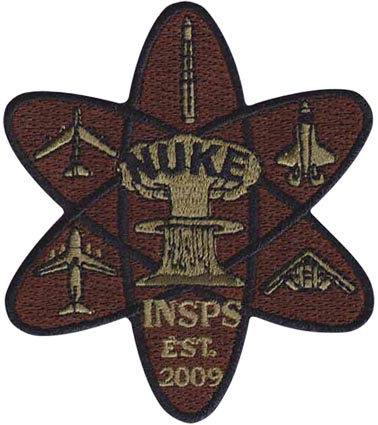Description
Computer made/mounted on velcro 3.5 inch-90mm
DEPT OF THE AIR FORCE INSPECTION AGENCY (DAFIA)
DAFIA traces its roots back to 1927 when the U.S. Army Chief of the Air Corps established an Inspection Division to perform technical inspections in support of flight safety objectives. By the end of World War II, this function was aligned under the Air Inspector. In Jul 1948, Air Force Letter No. 20-4 directed consolidation of Headquarters U.S. Air Force inspection activities at Kelly AFB, TX, and provided for inspectors general at echelons of command below Headquarters USAF.
On 20 Sep 1950, the Vice Chief of Staff authorized the creation of a Directorate of Technical Inspections at Norton AFB, CA. Organized operations began in Feb 1951 with 128 officers, 29 noncommissioned officers and 31 civilians. Duties for this function included evaluations of and recommended improvements to the maintenance, modification and overhaul of aircraft, related components and equipment.
To complete the consolidation of activities required for effectively conducting its technical inspection mission, in Aug 1951, the Deputy IG at Norton AFB subsumed the Directorate of Procurement and Supply Inspection which was transferred from the Pentagon. Moreover, in 1951, the first Medical Service Inspection team was used to evaluate military treatment facilities and programs across the US Air Force using state-of-the-art standards focusing on improving the quality and safety of care provided by health care organizations. By the end of 1952, the Directorate of Readiness Inspection was also moved from the Deputy IG at Kelly AFB to Norton AFB to become the Directorate of Readiness and Materiel Inspections.
On 7 Jan 1963, the Deputy Inspectors General for Safety and Inspections were combined to establish the U.S. Air Force Deputy Inspector General; however, safety activities were still divided. The Directorate of Aerospace Safety remained at Norton AFB while the Directorate of Nuclear Safety resided at Kirtland AFB, NM. Under this plan, a single deputy was responsible for the Air Force Inspection System and safety programs.
In July 1964, the Office of Assistant for Medical Services was formed within the Deputy Inspector General organization, and the first legal advisor was assigned in June 1965.
On 31 Dec 1971, the Air Force Inspection and Safety Center was activated to replace the 1002d Inspector General Group.
As a result of the Goldwater-Nichols Act, the Inspector General moved directly under the Secretary of the Air Force in Sep 1986. During this period, AFISC began planning for a new concept of multi-MAJCOM inspections, which were implemented in 1987 and 1988.
Congress approved closure of Norton AFB in 1990, and AFISC began initial planning to move its operation to Kirtland AFB, New Mexico. In August 1991, the center was divided into the Air Force Inspection Agency and the Air Force Safety Agency, now the Air Force Safety Center. Both organizations settled at Kirtland AFB in Jul 1993.
In Feb 2021, the Agency realigned Oversight/Evaluation Directorate’s resources into the Inspection and Nuclear Inspection directorates. The realignment enabled organizational efficiencies and postured the Agency to better address SECAF and CSAF priorities on readiness and lethality while minimizing risk to the nuclear enterprise. Additionally, this reorganization realigned SAF/IG’s inspections policy directorate to fall under DAFIA and established the Inspection Policy and Requirements Directorate, Operating Location – A, located at the Pentagon, Washington, DC.
DAFIA is composed of six directorates: Enterprise Support (ET), Inspections (ID), Medical Operations (SG), Mission Support (MS), Nuclear Inspections (NI), and Inspection Policy and Requirements (IR).
Duties and Responsibilities
Integrates core team of medical inspectors with major command (MAJCOM) inspector general (IG) teams to conduct Unit Effectiveness Inspections (UEI)
Collaborates with the Department of the Air Force Surgeon General’s office, Air Force Medical Readiness Agency, and MAJCOMs/F-COMs on policies and procedures pertaining to UEIs
Inspects radioactive material permits issued to authorized Department users under the master materials license granted by the Nuclear Regulatory Commission
Provides oversight of MAJCOM-conducted Nuclear Surety Inspections (NSI) and select initial NSIs to assess MAJCOM IG performance and provide The Inspector General (TIG), Chief of Staff of the Air Force (CSAF) and Secretary of the Air Force (SecAF) an independent perspective of the safety, security and reliability of the Department’s Nuclear Enterprise
Integrates a Core Team of nuclear inspectors with MAJCOM IG teams to conduct NSIs
Provides standardized basic, nuclear and management inspection training for Department inspectors and augmentees
When directed, evaluates and reports on high-impact, high-visibility programs that are of significant interest to SecAF, CSAF, CSO, or SAF/IG
Independently conducts unit effectiveness, management, statutory and special interest item inspections for Department Forward Operating Agencies and Direct Reporting Units
Plans and conducts management inspections of Air Force MAJCOM HQs and Air Staff Directorates to report on their efficiency, economy and discipline
Observes the conduct and performance of United States Space Force and Air Force MAJCOM IG teams during all inspection types and provides feedback to IGs and SAF/IG on their effectiveness to improve and standardize processes across the Air Force Inspection System (AFIS)
Serves as the Department’s gatekeeper to manage the centralized inspection schedule which includes all inspection activities by external, non-Air Force agencies
Consolidates and reports statutory information to Congress and the Department of Defense
Provides subject-matter expertise related to training, inspections and other activities directed or supported by Chairman of the Joint Chiefs of Staff Instruction 3263.05E, Nuclear Weapons Technical Inspections
Conducts Department-wide analysis on IG inspections to identify systemic issues, trends and leading indicators across the Department allowing senior leaders to make data-driven decisions
Manages the Inspector General Inspection Reporting System (TIGIRS), a collection of information technology systems and capabilities that provide inspection scheduling, planning, execution, and post-inspection analysis and reporting
Maintains an appropriate staff to provide legal reviews and recommendations to the command team
Provides agile, relevant inspection policy to enable commanders to attain and maintain the highest levels of readiness and compliance in support of national defense objectives
Provides A1 and A6 support for all DAFIA personnel
